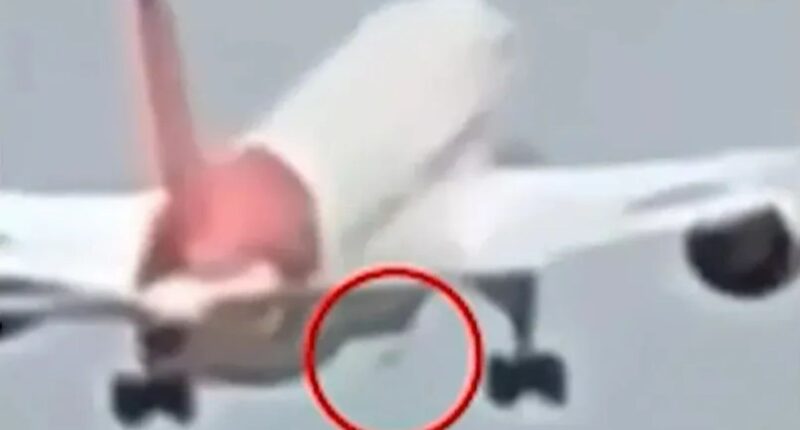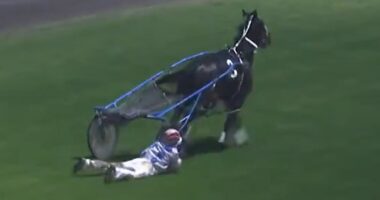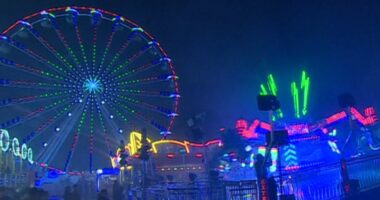A BOMBSHELL new video proves what caused the Air India plane to crash and burn just after takeoff, an aviation expert has claimed.
Meanwhile, the second black box containing key cockpit voice recordings has been found – expected to reveal the pilots’ panic as the plane went down.


The recently released footage, described as a “game-changer,” provides a clearer depiction of the aircraft plunging through the sky and erupting into a fiery explosion, resulting in the fatalities of almost all 242 passengers onboard and additional casualties on the ground.
Analysis by commercial airline pilot Steve Schreiber, renowned for investigating aviation incidents, confirms that the Boeing 787 destined for Gatwick experienced a sudden loss of power immediately following takeoff.
Schreiber points out a crucial observation in the video indicating that the Dreamliner encountered a “dual engine failure” preceding what has been identified as the most catastrophic aviation incident in over ten years.
Initially Captain Steve believed a simple error in the cockpit was to blame, possibly related to the landing gear which did not retract.
But after reviewing the HD clip, Steve is convinced that something caused both of the engines to cut out.
He pointed out a “protrusion on the belly of the aircraft”, underneath which is a “little grey dot”.
Steve said this is evidence of the Ram Access Turbine (RAT) deploying on the plane, which failed to climb more than 450ft.
He said: “Many aeroplanes have it. It is just behind the wing on the right side of the aeroplane, there is a little door that holds it in.
“It looks like a little Evinrude motor, it’s a little two bladed prop.
“The purpose is to provide electrical and hydraulic pressure for the aircraft on an extreme emergency.”
Steve explained there are three things which could cause the RAT to deploy on a 787: “A massive electrical failure, a massive hydraulic failure, or a dual engine failure.”
He also explained that RAT make a “distinctive sound” like a single-propeller plane, which can be heard in the video.
Steve concluded: “It is evidence for us it was dual engine failure, most likely. It could have been electrical issue, it could have been hydraulic issue, it could have been either one of that.
“But I think the fact the aeroplane is mushing out the sky gives the idea it was a dual engine failure.”



Officials combing the crash site have found the second black box, which will let them reconstruct what happened second-by-second.
It holds the data from the Cockpit Voice Recorder (CVR) – which captured all cockpit audio including pilot conversations, radio transmissions, warning alarms and ambient mechanical sounds.
Planes usually carry two black boxes, which are small but tough electronic flight data recorders.
One records flight data, such as altitude and speed, whilst the other monitors the cockpit sound.
What is Ram Air Turbine?
A RAM Air Turbine, known as RAT, is a small wind turbine fitted into planes which generates power in the case of emergency.
It will deploy if the main engine stops generating power for any reason.
When activated, the small turbine stick out from below the wing or fuselage, and harnesses the wind power caused by the plane’s speed.
The airflow makes it spin round, in turn generating electricity which can be used.
This happens using a hydraulic pump or electrical generator linked up to the turbine.
A key feature of RAM is that is acts independently from the aircraft’s engine and other generation means, meaning it can in theory be used to create power even when the main systems go down.
The first was recovered from a rooftop near where the plane came down just 28 hours after the crash.
We already know that the pilot, Captain Sumeet Sabharwal, made a desperate mayday call to air traffic control in the moments before the disaster.
He cried out: “‘Thrust not achieved […] falling […] Mayday! Mayday! Mayday!”
The two pilots then wrestled for 17 seconds with the controls as the jet sank through the air before careening into the buildings below.
Sabharwal had 22 years of experience and had racked up 8,200 in the air.
The plane gained just a few hundred feet of altitude when the power apparently cut out, killing more Brits than any air disaster since 9/11.
Despite more than 270 people dying in the catastrophe, the pilot has been credited with saving “dozens of lives”.


Sabharwal diverted the jet at the last second to avoid slamming into a three-storey apartment building, according to locals on the ground.
All 18 families in the three-storey building under the flight path are convinced they owe their lives to Captain Sumeet Sabharwal.
He managed to divert the plane towards a patch of grassland.
The locals raced from their homes in Ahmedabad when a fireball from 90 tons of aviation fuel ignited as the plane slammed into the ground.
The aircraft obliterated the top two floors of a disused four-storey military building.
But the fire tore through the college’s hostel, killing dozens of students and staff who were having lunch in the canteen.

















